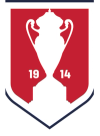The hiatus, thankfully, was short lived. Players, who were Cup tied in both the Amateur Cup and that year’s Open Cup, as well as by league roster deadlines, prevailed upon the manager to keep the club alive. It was rumored that the players otherwise would have done so on their own.
By that point, the team was already past the Third Round of the Open Cup – having beaten up on Bartunek-Slavia of Cleveland 6-1 in the First Round. And after a Second Round bye, they defeated the Buffalo Becks by a 6-0 margin. Steve Grivnow netted a hat trick and Bob Craddock, a National Soccer Hall of Fame inductee in the Class of 1997, added a brace. Harry Pitchock also pitched in with a goal.
From that point on, it seemed the Harmarville men were intent not only on challenging for the U.S. Open Cup title, but also on proving their supremacy in Western Pennsylvania.
The Fourth Round match was on the road against Morgan in front of more than 3,000 fans on a muddy Bridgeville Park field that was seen as an advantage to the home side. Harmarville held their high-scoring opponents, who tallied 70 goals in 13 games up to that point in the season, to a single first-half strike in rolling to a 4-1 win.
Grivnow, a member of the 1948 Team USA Olympic squad, opened the scoring for Harmarville. A penalty kick by Hall of Famer Nick DiOrio made the score 2-0. Morgan pulled one back and then Craddock made it 3-1 before the half. Don Utchel rounded out the scoring in the second half, as the Harmarville defense closed down Morgan’s potent attack.
The Hurricanes left no doubt they were the top dog in coal country by routing Heidelberg, a Finalist in the previous year’s Open Cup (1951) by the outrageous scoreline of 9-1.
All of Harmarville’s big names got in on the scoring act that night. Bob Craddock and his brother Tom started the onslaught on another muddy pitch, this time the Freeport Road Ground. Grivnow, Merle Utchel and DiOrio each tallied twice and 1978 Hall of Fame inductee Bernabei closed out the scoring.
Clash of Old-Time Titans (and USMNT Mates)
The dismantling of the 1949 Open Cup champion Morgans gave Craddock and DiOrio the opportunity to reunite with four of their teammates from the memorable World Cup of 1950 in Brazil — Frank Borghi, Charlie ‘Gloves’ Colombo, Frank ‘Pee Wee’ Wallace and Gino Pariani, who featured on the St Louis-based Simpkins Ford squad.
The Pittsburgh side had the better of Simpkins at home in the first leg of the next round (National Semifinals) but they couldn’t find the back of the net.
Just inside the first ten minutes, Merle Urchel had a shot stopped by Borghi, then Bob Craddock sent one wide. Grivnow finally beat the excellent Borghi in the 40th minute, but the goal was disallowed because of a foul and the match ended in a scoreless draw.
The return fixture, played at North Side Park in St. Louis, was almost as tight as the first. Sixteen minutes in, Pete Traina spun and took a shot that Harmarville keeper Don Malinowski stopped but could not control. The ball fell to the foot of Marv Marshak who angled his shot to give Simpkins a 1-0 lead.
Just two minutes later, DiOrio evened things up, tapping in a shot past Borghi. The contest remained level until the dying seconds, when Bob Craddock was able to slip past Colombo and beat the St. Louis goalkeeper to force the 2-1 margin.
Based on their play against Simpkins, legendary St. Louis soccer writer Dent McSkimming predicted Harmarville would have no problem getting past the Eastern Finalist Philadelphia Nationals, who had defeated the New York German Hungarians by a 4-3 aggregate in their series and were full professionals of the era’s dominant American Soccer League (ASL).
The reality wasn’t that easy, although it started out that way on Harmarville’s spacious Freeport ground.
Grivnow scored just eight minutes in, following up on Utchel’s free kick. Less than ten minutes later, the speedy winger made the advantage 2-0. Things quickly fell apart, as Glen Owens took a shot that caromed off the underside of the crossbar past Malinowski, who had to make several spectacular saves.
Owens scored again in the 37th minute. Johnny Cier made it 3-2 just before halftime and added another goal just beyond the interval. After Sonny Yakovic moved from full-back to center forward, he put Harmarville back in the game, scoring in the 80th minute. An equalizer from DiOrio four minutes later was called back for a handball, and another potential equalizer by Sonny Yakovic was stripped off his foot by Nationals goalkeeper Leo Radzarry.
1952 Final 2nd Leg Heroics against Philly’s Nationals
With their backs already to the wall, needing a two-goal margin of victory in the two-legged Final and their speedy attack hampered by the narrow confines of Philadelphia’s Holmes Stadium, Harmarville’s Open Cup hopes nearly came to a crashing end.
After a scoreless first half, Nick Kropfelder found the net seven minutes into the second stanza. With a two-goal margin in the aggregate, the Nats, losers in the 1949 Final to Morgan, appeared to be coasting to lifting the Cup.
But, after two Harmarville shots hit the post, DiOrio scored with ten minutes left in the game – and then Yakovic forced overtime with another goal in the 88th minute.
The first of the two 15-minute overtime periods ended scoreless. Early in the second period, though, Don Urchel dribbled half the length of the field to score. Six minutes later, Grivnow added an insurance tally, at least his ninth goal of the competition, as the two-game Final series ended 7-5 for the Hurricanes.
Harmarville made it to a second straight Open Cup Final the next year, falling in 1953 to the Chicago Falcons by 2-0 and 1-0 scores over two legs. The Hurricanes rebounded to win a second title in 1956, using a similar script as the one that earned them victory in 1952. After losing the first game 1-0, they roared back – this time at home in coal country – to win 3-1 in overtime.
Charles Cuttone is a writer/author, historian and three-time winner of the National Soccer Coaches Association writing award. His latest book, The Soccer Book of Why, published by Lyons Press, will be out in June.








